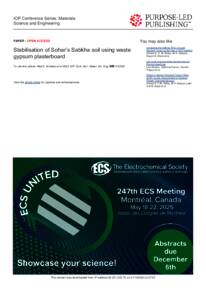Document
Stabilisation of Sohar's Sabkha soil using waste gypsum plasterboard.
Identifier
DOI: 10.1088/1757-899X/849/1/012028
Source
IOP Conference Series: Materials Science and Engineering. v. 849, 1, 012028
Contributors
Ganiyu, Abideen A. , Author
Badr, Atef., Author
Country
England.
City
Bristol
Publisher
Institute of Physics Publishing.
Gregorian
2020-05-29
Language
English
English abstract
Sabkha soil are salt-encrusted desert flats typically found in arid regions. Construction developments on naturally occurring Sabkha soils are usually problematic. This study examines the properties of Sabkha soil obtained from Sohar city of Oman. The Sabkha soil samples were further treated with Gypsum obtained from waste plasterboards at varying percentages of 3, 6, 9 and 12 with a view to stabilising the soil. From the results, Sohar Sabkha soil is a poorly graded sand (SP) with AASHTO classification of A-2-7(0), therefore, it is unsuitable for supporting infrastructures in its natural form. The pH test confirms the reaction between Sabkha and Gypsum, while both the compaction and unconfined compression strength (UCS) tests revealed the optimum percentage of gypsum required to enhance the properties of Sabkha soil to be 6%. The California Bearing Ratio (CBR) test yielded a 33.3% increase in CBR value for Sabkha treated with 6% of Gypsum over untreated Sabkha. Overall, a better understanding of sabkha soil and the confirmation of the potential use of Gypsum for its stabilisation was achieved in this study.
ISSN
1757-8981
Category
Conferences & workshops

